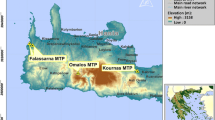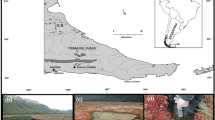Abstract
Macroinvertebrates of 49 (27 temporary and 22 permanent) ponds located in the Presidential Estate of Castelporziano (Rome) were studied from 1989 to 2004 to investigate their community ecology and to provide a first estimation of their conservation value. More than 300 taxa (about 70 % identified to species) were collected. The main environmental factors influencing the number of species in the study ponds were hydroperiod length, depth, surface area, dissolved oxygen concentration and macrophyte species richness and abundances. Permanent biotopes generally hosted higher number of taxa than temporary ones. Some taxa were exclusive or more abundant in a pond type. Functional organization (functional feeding groups, habits and resistance to desiccation) of the community appeared similar in the two pond types but differed among mesohabitats. Up to date, about 62 % of the taxa collected have an unknown status with respect to their distribution in Italy (common, rare, threatened and vulnerable). We identified 50 target species with peculiar ecological requirements and/or geographical distribution to promote effective practical basis for pond conservation in Italy. The distribution of rare, vulnerable or threatened species within the ponds studied suggests that the two pond types and all mesohabitats therein should be considered for the sampling procedure to obtain a correct evaluation of pond conservation.
Similar content being viewed by others
References
Bazzanti M, Della Bella V (2004) Functional feeding and habit organization of macroinvertebrate communities in permanent and temporary ponds in Central Italy. J Freshwat Ecol 19:493–497
Bazzanti M, Baldoni S, Seminara M (1996) Invertebrate macrofauna of a temporary pond in Central Italy: composition, community parameters and temporal succession. Arch Hydrobiol 137:77–94
Bazzanti M, Seminara M, Baldoni S (1997) Chironomids (Diptera: Chironomidae) from three temporary ponds of different wet phase duration in Central Italy. J Freshwat Ecol 12:89–99
Bazzanti M, Seminara M, Baldoni S, Stella A (2000) Macroinvertebrates and environmental factors of some temporary and permanent ponds in Italy. Ver Intern Ver Limnol 27:936–941
Bazzanti M, Della Bella V, Seminara M (2003) Factors affecting macroinvertebrate communities in astatic ponds in Central Italy. J Freshwat Ecol 18:537–548
Bazzanti M, Grezzi F, Della Bella V (2008) Chironomids (Diptera) of temporary and permanent ponds in Central Italy: a neglected invertebrate group in pond ecology and conservation. J Freshwat Ecol 23:219–229
Bazzanti M, Della Bella V, Grezzi F (2009) Functional characteristics of macroinvertebrate communities in Mediterranean ponds (Central Italy): influence of water permanence and mesohabitat type. Ann Limnol - Int J Limnol 45:29–39
Bazzanti M, Coccia C, Dowgiallo MG (2010) Microdistribution of macroinvertebrates in a temporary pond of Central Italy: taxonomic and functional analyses. Limnologica 40:291–299
Beisel JN, Usseglio-Polatera P, Thomas S, Morateau JC (1998) Effects of mesohabitat sampling strategy on the assessment of stream quality with benthic invertebrate assemblages. Arch Hydrobiol 142:493–510
Beja P (2000) Ecology and conservation of Portuguese temporary ponds. Proceeedings of Ponds Conference 1998. The Ponds Conservation Trust, Oxford, pp 91–95
Boothby J (1997) Ponds conservation: towards a delineation of pondscape. Aquat Conserv: Mar Freshwat Ecosyst 7:127–132
Bosi G (2001) Abundance, diversity and seasonal succession of dytiscid and noterid beetles (Coleoptera: Adephaga) in two marshes of the Eastern Po Plain (Italy). Hydrobiologia 459:1–7
Bratton JKH (1990) Seasonal pools. An overlooked invertebrate habitat. Br Wildl 2:22–29
Briers RA, Biggs J (2003) Indicator taxa for the conservation of pond invertebrate diversity. Aquat Conserv: Mar Freshwat Ecosyst 13:323–333
Carchini G, Della Bella V, Solimini AG, Bazzanti M (2007) Relationships between the presence of odonate species and environmental characteristics in lowland ponds of central Italy. Ann Limnol - Int J Limnol 43:81–87
Carpenter SR, Elser JJ, Olson KM (1983) Effects of roots of Myriophyllum verticillatum L. on sediment redox conditions. Aquat Bot 17:243–249
CEC (1992) Council of European Communities Directive 92/43/EC on the conservation of natural habitats and of wild fauna and flora. Official Journal of European Communities, L206
CEC (2000) Council of European Communities Directive 2000/60/EEC of 23 October 2000 establishing a framework for community action in the field of water policy. Official Journal of European Communities, L327/1
CEC (2005) Common implementation strategy for the water framework directive (2000/60/EC). Guidance document. N12. Horizontal guidance on the role of wetlands in the water journal of European Communities, Luxembourg
Céréghino R, Oertli B, Bazzanti M, Coccia C, Compin A, Biggs J, Bressi N, Grillas P, Hull A, Kalettka T, Scher O (2012) Biological traits of European pond macroinvertebrates. Hydrobiologia 689:51–61
Collinson NH, Biggs J, Corfield A, Hodson MJ, Walker D, Whitfield M, Williams PJ (1995) Temporary and permanent ponds: an assessment of the effects of drying out on the conservation value of aquatic macroinvertebrate communities. Biol Conserv 74:125–133
Crowder LD, Cooper WE (1982) Habitat structural complexity and the interaction between bluegills and their prey. Ecology 63:1802–1813
Cummins KW, Wilzbach MA (1985) Field procedures for analysis of functional feeding groups of stream invertebrates, Appalachian Environmental Laboratory, Maryland, Frostburg, Contr. N° 1611
Czachorowski S, Lewandowski K, Wasilewska A (1993) The importance of aquatic insects for landscape integration in the catchment area of the River Gizela (Masurian Lake District, northeastern Poland). Acta Hydrobiol 35:49–64
Della Bella V, Bazzanti M, Chiarotti F (2005) Macroinvertebrate diversity and conservation status of Mediterranean ponds in Italy: water permanence and mesohabitat influence. Aquat Conserv: Mar Freshwat Ecosyst 15:583–600
Diehl S, Kornijow R (1998) Influence of submerged macrophytes on trophic interaction among fish and macroinvertebrates. In: Christoffersen K, Jeppesen E, Sondergaard Ma, Sondergaard Mo (eds) The structuring role of submerged macrophytes in lakes. Springer, New York, pp 24–46
EPCN European Pond Conservation Network (2007) Developing the pond manifesto. Ann Limnol - Int J Limnol 43:221–232
EPCN European Pond Conservation Network (2008) The Pond Manifesto. EPCN. Available on internet at http://campus.hesge.ch/epcn/projects.asp
Español C, Gallardo B, Comın FA, Pino MR (2015) Constructed wetlands increase the taxonomic and functional diversity of a degraded floodplain. Aquat Sci 77:27–44
Foster GN, Nelson BH, Bilton DT, Lott DA, Merritt R, Weyl RS, Eyre MD (1992) A classification and evaluation of Irish water beetle assemblages. Aquat Conserv: Mar Freshwat Ecosyst 2:185–208
Heino J (2005) Functional biodiversity of macroinvertebrate assemblages along major ecological gradients of boreal headwater streams. Freshw Biol 50:1578–1587
IUCN (2001) Red list categories and criteria: Version 31. Gland, IUCN Species Survival Commission, p 30
Merritt RW, Cummins KW (1996) An introduction to the aquatic insects of North America, Kendall/Hunt, Dubuque, p 862
Mura G (1997) The life history of Chirocephalus kerkyrensis Pesta (Crustacea, Anostraca) in temporary waters of Circeo National Park (Latium, Italy). Hydrobiologia 346:11–23
Newman RM (1991) Herbivory and detritivory on freshwater macrophytes by invertebrates: a review. J N Am Benth Soc 10:89–114
Nicolet P (2001) Temporary ponds in the UK: a critical biodiversity resource for freshwater plants and animals. Freshwater Forum 17:16–25
Nicolet P, Biggs J, Fox G, Hodson MJ, Reynolds C, Withfield M, Williams P (2004) The wetland plant and macroinvertebrate assemblages of temporary ponds in England and Wales. Biol Conserv 120:265–282
Oertli B, Joye DA, Castella E, Juge R, Cambin D, Lachavanne JB (2002) Does size matter? The relationship between pond area and biodiversity. Biol Conserv 104:59–70
Pederzani F (1998) Note su alcuni Idroadefagi e Palpicorni della Tenuta Presidenziale di Castelporziano (Coleoptera (Haliplidae, Hygrobidae, Dytiscidae, Hydraenidae, Helophoridae, Hydrochidae, Hydrophilidae). Boll Ass Rom Ent 52:27–32
Rosenberg DM, Resh VH (eds) (1993) Freshwater biomonitoring and benthic macroinvertebrates. Chapman & Hall, London, p 488
Ruffo S, Stoch F (eds.) (2006) Checklist and distribution of the Italian Fauna. Museo Civico di Storia Naturale di Verona-Ministero dell’Ambiente. (With CD Rom), pp 307
Schramm HL, Jirka KJ (1989) Effects of aquatic macrophytes on benthic macroinvertebrates in two Florida lakes. J Freshwat Ecol 5:1–12
Standen V (1999) Quantifying macroinvertebrate taxon richness and abundance in open and forested pool complexes in the Sutherland Flows. Aquat Conserv: Mar Freshwat Ecosyst 9:209–217
Thomaz SM, Cunha ER (2010) The role of macrophytes in habitat structuring in aquatic ecosystems: methods of measurement, causes and consequences on animal assemblages’ composition and biodiversity. Acta Limnol Bras 22:218–236
Utzeri C (1999) Gli Odonati nella Tenuta di Castelporziano: una Rassegna Commentata. In Le Piscine di Castelporziano. Progetto di Monitoraggio Ambientale della Tenuta Presidenziale di Castelporziano. Seminario tematico GDL FAUNA: Roma, pp 6
White J, Irvine K (2003) The use of littoral mesohabitats and their macroinvertebrate assemblages in the ecological assessment of lakes. Aquat Conserv: Mar Freshwat Ecosyst 13:331–351
Wiggins GB, Mckay RJ, Smith IM (1980) Evolutionary and ecological strategies of animals in annual temporary pools. Arch Hydrobiol Suppl 58:97–206
Williams P, Whitfield M, Biggs J, Bray S, Fox G, Nicolet P, Sear D (2003) Comparative biodiversity of rivers, streams, ditches and ponds in an agricultural landscape in Southern England. Biol Conserv 115:329–341
Wood RJ, Greenwood MT, Agnew MD (2003) Pond biodiversity and habitat loss in the UK. Area 35:206–216
Acknowledgments
I wish to thank S. Baldoni, C. Coccia, V. Della Bella, S. Giangi, F. Grezzi and M. Seminara for their help in the field and laboratory work in different periods of study. This work relied on the invaluable help provided by the following specialists in the identification of some taxonomic groups: A. Carapezza (Heteroptera), G. Carchini (Odonata), F. Cianficconi (Trichoptera), L. De Marzo (larval Coleoptera), M. Di Luca (Diptera Culicidae), A. Di Sabatino (Hydracarina), M. Iberite (macrophytes), G. Manganelli (Gastropoda) and F. Pederzani (adult Coleoptera). Some taxonomic experts cited above provided also information on the distribution and conservation status of species in Italy.
Author information
Authors and Affiliations
Corresponding author
Additional information
This peer-reviewed article is a result of the multidisciplinary project coordinated by the ‘‘Accademia Nazionale delle Scienze detta dei XL’’, Rome, Italy, in the area of the presidential estate of Castelporziano near Rome.
Electronic supplementary material
Below is the link to the electronic supplementary material.
Rights and permissions
About this article
Cite this article
Bazzanti, M. Pond macroinvertebrates of the Presidential Estate of Castelporziano (Rome): a review of ecological aspects and selecting indicator taxa for conservation. Rend. Fis. Acc. Lincei 26 (Suppl 3), 337–343 (2015). https://doi.org/10.1007/s12210-015-0431-4
Received:
Accepted:
Published:
Issue Date:
DOI: https://doi.org/10.1007/s12210-015-0431-4




